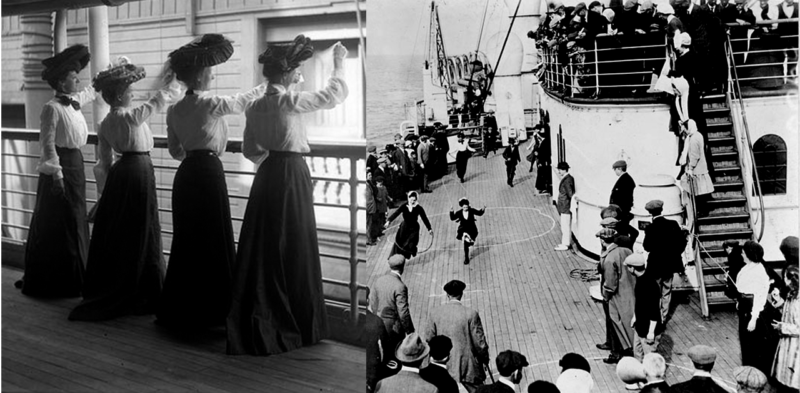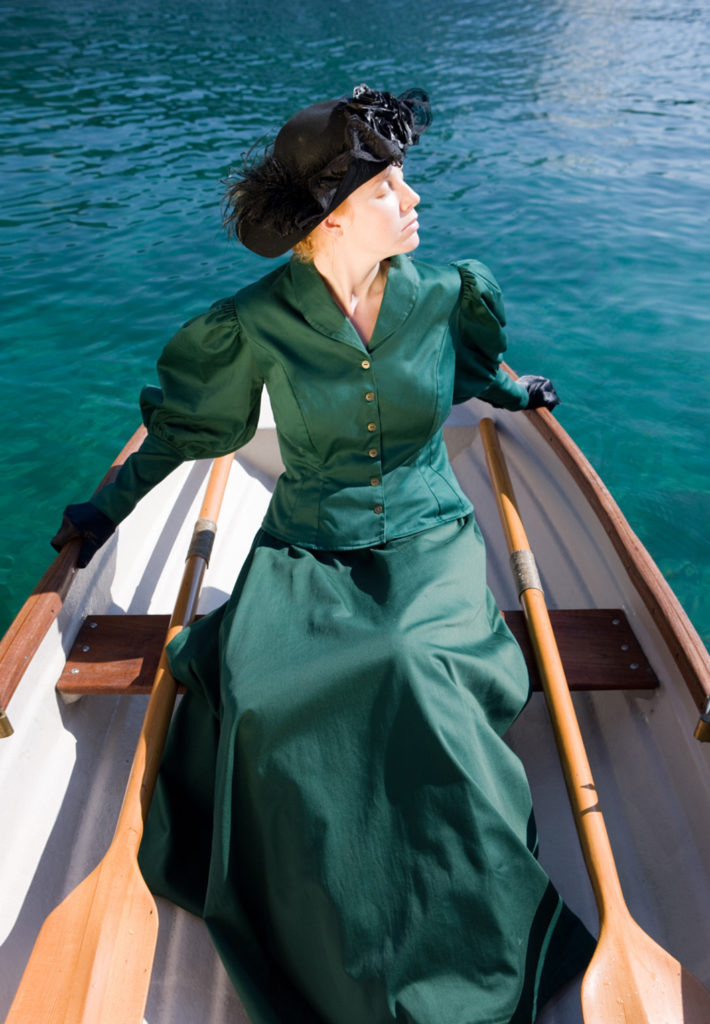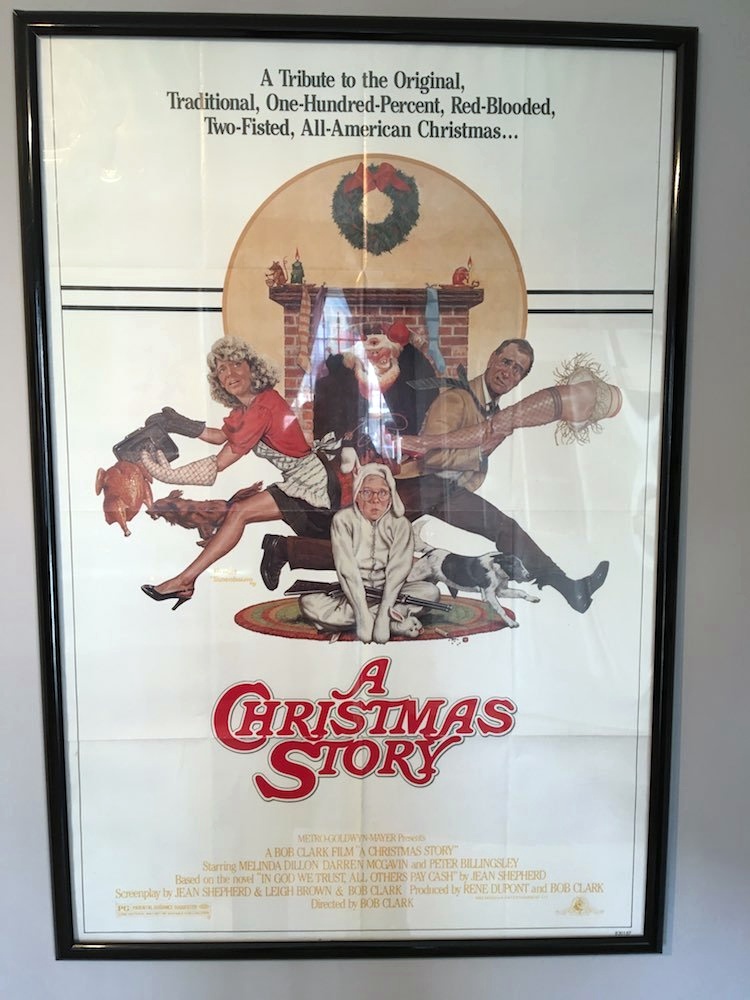Updated February 4, 2019
It seems that some things never change. The details may change but the subject is the same – the savvy traveler. Today, we pack for a vacation or business trip that may include air travel. There are tips and tricks to get the most out of your wardrobe. Here’s a glimpse of what transcontinental travel by ship was like during the late Victorian era. Augusta Salisbury Prescott presents this advice in the May 1892 edition of Godey’s Lady’s Book as posted by JD Thomas at Accessible Archives.
“Have your steamer trunk as low a one as you can buy, so that it will be sure to slip in under the berth in your state-room, no matter how low the berth may be. If you share the state-room with someone else, you will find that it is very much more convenient to have a low, flat trunk that will serve as a settee, than a round high one which constantly proclaims itself as an aggressive trunk.”
Today we have to be sure our carry-on luggage fits under the seat in front of us or in the overhead bin. No one wants an ‘aggressive trunk!’
“It is all very pretty to have a nice traveling dress, and your first thought as you get ready to go away, is put upon the gown that you will wear. It isn’t a bad idea to have one neat stylish suit for traveling, but bear in mind that you do not want to cross the ocean in anything which is any good at all. The first dash of the salt spray leaves traces behind it and the constant wetting and dampness will draw any dress out of shape.”
Oh, the perils of oceanic travel! The modern wardrobe might be different but the idea is the same, save your good clothes for your destination.
“Take then with you an old half worn-out dress. Do not mind if it is soiled or even ragged, because no one is going to notice you when once the ship is started and there is a wonderful ocean to gaze and look upon by the hour without tiring.”
“When your friends go down to see you off on the ship, you may have on the pretty traveling dress, but as soon as you are out of sight of land, you will be willing to put on the old dress and will not care to change it again until the journey is completed.”
Jeans and a t-shirt are the equivalent of the ‘half worn-out’ dress in the modern wardrobe. Once aloft, there is a beautiful sea of clouds or the landscape below to enjoy (if you are lucky enough to have a window seat).
“You will want an old ulster also—the warmest one you own. If you have a mackintosh so much the better, and you can wear under it a small warm jacket if the mackintosh is not sufficient. A pair of heavy gloves, a hat that can be tied on securely and one or two heavy veils will complete your outside costume.”
We still try to be prepared for any weather me may encounter while we are away today. The above description may be used for the flight (with modern modifications). Cabins can be so cold!
“The steamer trunk will accommodate very nicely the traveling dress when not in use, and there will be room also for an evening dress and any trifles which you regard indispensable to your comfort. It is well, in providing the evening dress, to select one that has two waists, one waist may be used for calling and other possible social occasions, while the dressier waist may be kept for the opera which you will be sure to visit, or the dinner parties to which some friend to whom you have letters of introduction, will invite you.”
Today’s equivalent is the one piece of checked luggage allowed by airlines. Great ideas on how to make your wardrobe more versatile are as important now as it was then.
“Now a word as to underclothing. To most women, the idea of wearing old underclothes is an abomination. Ragged flannels, frayed linen and the like, are regarded as a hissing and a by-word, and no woman with a particle of self-respect will deliberately clothe herself in such garments if she can get any others to put on.
But now, you dear particular little woman, who always wear underclothing all of one set, and would rather die than mix Torchon with Hamburg, hold your patience for a moment and try to restrain your tongue and countenance while I tell you some of the advantages of old underclothing while you are going abroad.
You will find it is very difficult to get washing done aboard ship. The prices are high and you have to wait a long time for your work. Your state-room is too small, and you do not care to keep soiled clothes lying around, and so before you know it you find yourself ‘chucking’ your soiled clothes out of the port-hole into the briny deep and forever afterward mourn the loss of that lovely set you threw overboard.
Now, tell me, why isn’t it better to take along six or seven complete suits of almost worn-out underclothing that you can wear once, and then conscientiously throw overboard to the sharks and whales? You will want to change your clothes very often, because they get so damp and soggy; and if you wear nice ones you will be sure to mourn your folly ever afterward.
Provide yourself then with as many sets of old flannel and muslin as you can save up in a year’s time, and then, folding the old clothes respectfully, place them in the steamer trunk, and when you get aboard ship you will wear them as proudly although they were the cherished silk which you wear when you are at home.”
I’m sure throwing undergarments overboard from a luxury liner is an offense today. But, the idea of having old clothes in the wardrobe when traveling and saving one or two good pieces for the destination makes as much sense today as it did then. Recollections
This is part of a larger article about women traveling abroad during the 1890s. There are quite a few gems including champagne and crackers to fight seasickness! Have fun exploring the rest of the story!















So true, Kelly! Maybe the rest of the article in Godey’s Ladies’ Magazine will help. Inquiring minds want to know!
I agree with only wearing the “good suit” for arrival and departure. It may well also be the bulkiest wardrobe item (especially if it includes a bustled petticoat) so, as with flying today, it’s best to wear the bulkiest and heaviest layers and pack the lighter ones.
The problem is hat storage. How does one manage multiple hat boxes? A single separate trunk?
I have gone camping a lot over the years and I still use that underware trick. Save their last use the camping trip then toss them.
As for the “aggressor trunks” they are for the storage hold for use at the destination. And in that case you want the rounded top one. You can not balance another on top of it so the rounded top trunks go on the top of the pile. The flat ones go on the bottom with all the others crushing it.